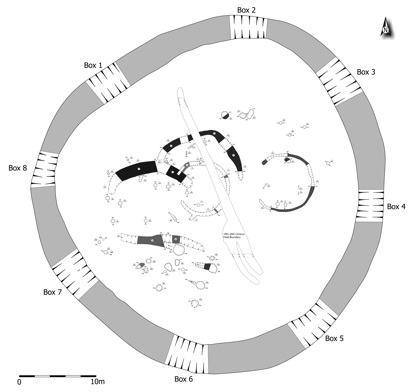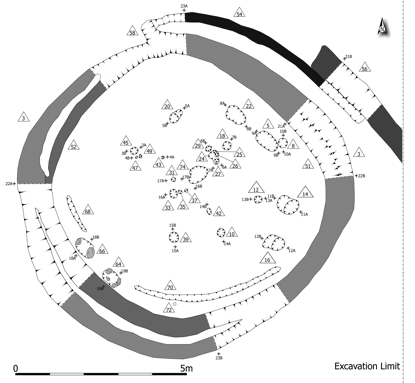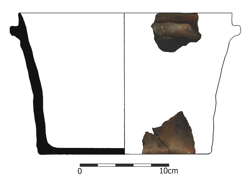County: Antrim Site name: Crumlin Recreation Grounds, Crumlin Rath, roundhouse
Sites and Monuments Record No.: N/A Licence number: AE/11/124
Author: Colin Dunlop
Site type: —
Period/Dating: —
ITM: E 715257m, N 875666m
Latitude, Longitude (decimal degrees): 54.616064, -6.215526
The site is located on the south-west side of the modern town of Crumlin, south of the Main Street and west of the railway line which bisects the town, in the townland of Ballytromery.
Two archaeological sites were excavated here, a rath (Area A, known from the Sites and Monument Record {SMR} as ANT059-007), and an Early Christian roundhouse (Area B).
The rath displayed two phases of occupation, Phase 1 saw the excavation of the ditch, the construction of 2 slot-defined round houses, the building of a viewing platform to overlook the bank which lay within the ditch (A feature also noted on the nearby Seacash Rath, Lynn 1980) and some industrial activity taking place. It is likely that the viewing platform was at least partially roofed and also served as an outhouse or animal shelter. The second phase saw the construction of 2 larger post-built roundhouses as well as some shallow curving slots of unclear function. The entrance would appear to have been represented by a narrowing in the ditch to the west; this was unusual as most raths have entrances to the east. Another unusual aspect of the entrance was the fact that it was not defined by an absence of ditch as is the case with most rath entrances where a gap in a bank corresponds with a gap in the ditch. It can only be assumed that the ditch at Crumlin Recreation grounds was crossed by a wooden bridge. This is a feature only identified on one other site, Seacash rath (Lynn 1980, 62; Edwards 1990, 22), which interestingly lies only 2km north of Crumlin and may indicate a regional variation in the style of entrance construction.
Radiocarbon determinations show that Phase 1 occupation was in the early to mid-7th century (a date of 1410+/-30BP which when 2 Sigma calibrated returned a date of AD600 to 660). Phase 2 began as early as 690AD, and potentially as late as 890AD (a date of 1270+/-30BP which when 2 Sigma calibrated returned a date of AD690 to 750 and AD760 to 890). However, as it was apparent that there were only two phases of occupation and we know that Phase 1 was in the early to mid-7th century, it would seem likely that Phase 2 occupation was immediately after Phase 1, and was more likely to have dated to the late 7th or early 8th centuries. The lack of a complex array of fills within the ditch also suggests that after the second phase of occupation the site was no longer used and the ditch was left to fill up through natural sedimentation. The final phase of activity concerning the ditch was its deliberate backfilling in the 18th century.
The house was 150m south-east of the rath. It was defined by a c. 9m diameter drip trench gully, with the internal structure being c. 8m in diameter. The body of the structure appears to have been constructed using pairs of large posts with evidence for a wall slot running between some of these pairs. While these posts and wall formed the exterior wall of the structure, further support was provided internally with another set of 6 posts, presumably supporting the roof. Gullies to the north and east of the structure allowed water to run away from the house. The entrance was to the south-east and lay between to large post-holes. This house would also appear to have been occupied in the early to mid-7th century (a date of 1450+/-30BP which when 2 Sigma calibrated returned a date of AD550 to 650) and may have been contemporary with the first phase of occupation of the rath. The slight shift in the position of the drip gully also suggested that the house was occupied for a prolonged period as this would only happen if the dwelling was re-roofed and reed thatch (the most probable roofing material considering the close proximity of the site to both Lough Neagh and a small river) would only need replaced after 25-50 years. The large quantity of burnt material found within the house suggests that it may have been destroyed after it ceased to be used, or given the violent nature of the era it may have been raised by attacking enemies while the occupants sought shelter in the neighbouring rath.

Area A, Crumlin.

Area B, Crumlin.

Phases at Crumlin.

Reconstruction of souterrain pot from C40 F41 at Crumlin.
References
Edwards, N. 1996, The Archaeology of Early Medieval Ireland, B.T. Batsford Ltd. London.
Lynn, C. 1980, ‘A rath in Seacash Townland, Co. Antrim’ in Ulster Journal Archaeology, vol.41, 1978.
Northern Archaeological Consultancy Ltd, Farset Enterprise Park, 638 Springfield Road, Belfast, BT12 7DY